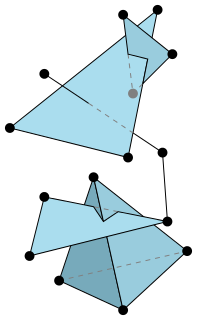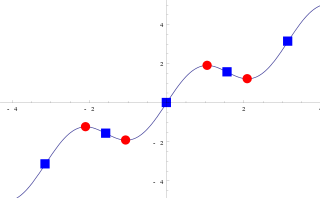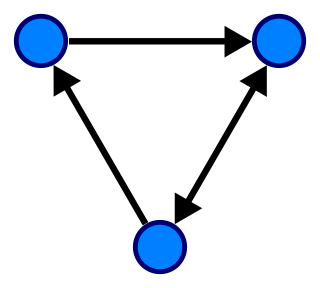In mathematics, a metric space is a set together with a metric on the set. The metric is a function that defines a concept of distance between any two members of the set, which are usually called points. The metric satisfies a few simple properties. Informally:

In computer science, a tree is a widely used abstract data type (ADT) that simulates a hierarchical tree structure, with a root value and subtrees of children with a parent node, represented as a set of linked nodes.

In mathematics, general topology is the branch of topology that deals with the basic set-theoretic definitions and constructions used in topology. It is the foundation of most other branches of topology, including differential topology, geometric topology, and algebraic topology. Another name for general topology is point-set topology.

In mathematics, a function is a binary relation over two sets that associates to every element of the first set exactly one element of the second set. Typical examples are functions from integers to integers or from the real numbers to real numbers.

In mathematics, an involution, or an involutory function, is a function f that is its own inverse,
In mathematics, a quiver is a directed graph where loops and multiple arrows between two vertices are allowed, i.e. a multidigraph. They are commonly used in representation theory: a representation V of a quiver assigns a vector space V(x) to each vertex x of the quiver and a linear map V(a) to each arrow a.

In mathematics, an abstract simplicial complex is a purely combinatorial description of the geometric notion of a simplicial complex, consisting of a family of non-empty finite sets closed under the operation of taking non-empty subsets. In the context of matroids and greedoids, abstract simplicial complexes are also called independence systems.
A finite-state transducer (FST) is a finite-state machine with two memory tapes, following the terminology for Turing machines: an input tape and an output tape. This contrasts with an ordinary finite-state automaton, which has a single tape. An FST is a type of finite-state automaton that maps between two sets of symbols. An FST is more general than a finite-state automaton (FSA). An FSA defines a formal language by defining a set of accepted strings, while an FST defines relations between sets of strings.

Critical point is a wide term used in many branches of mathematics.
In mathematics, subshifts of finite type are used to model dynamical systems, and in particular are the objects of study in symbolic dynamics and ergodic theory. They also describe the set of all possible sequences executed by a finite state machine. The most widely studied shift spaces are the subshifts of finite type.
In graph theory, a haven is a certain type of function on sets of vertices in an undirected graph. If a haven exists, it can be used by an evader to win a pursuit-evasion game on the graph, by consulting the function at each step of the game to determine a safe set of vertices to move into. Havens were first introduced by Seymour & Thomas (1993) as a tool for characterizing the treewidth of graphs. Their other applications include proving the existence of small separators on minor-closed families of graphs, and characterizing the ends and clique minors of infinite graphs.
Boolean algebra is a mathematically rich branch of abstract algebra. Just as group theory deals with groups, and linear algebra with vector spaces, Boolean algebras are models of the equational theory of the two values 0 and 1. Common to Boolean algebras, groups, and vector spaces is the notion of an algebraic structure, a set closed under zero or more operations satisfying certain equations.
In topology, a branch of mathematics, the ends of a topological space are, roughly speaking, the connected components of the "ideal boundary" of the space. That is, each end represents a topologically distinct way to move to infinity within the space. Adding a point at each end yields a compactification of the original space, known as the end compactification.
In the mathematics of binary relations, the composition relations is a concept of forming a new relation R ; S from two given relations R and S. The composition of relations is called relative multiplication in the calculus of relations. The composition is then the relative product of the factor relations. Composition of functions is a special case of composition of relations.
In the mathematical subject of group theory, the Grushko theorem or the Grushko–Neumann theorem is a theorem stating that the rank of a free product of two groups is equal to the sum of the ranks of the two free factors. The theorem was first obtained in a 1940 article of Grushko and then, independently, in a 1943 article of Neumann.

In mathematics, and more specifically in graph theory, a directed graph is a graph that is made up of a set of vertices connected by edges, where the edges have a direction associated with them.
In mathematics, the concept of graph dynamical systems can be used to capture a wide range of processes taking place on graphs or networks. A major theme in the mathematical and computational analysis of GDSs is to relate their structural properties and the global dynamics that result.

The Abelian sandpile model, also known as the Bak–Tang–Wiesenfeld model, was the first discovered example of a dynamical system displaying self-organized criticality. It was introduced by Per Bak, Chao Tang and Kurt Wiesenfeld in a 1987 paper.

In graph theory and statistics, a graphon is a symmetric measurable function , that is important in the study of dense graphs. Graphons arise both as a natural notion for the limit of a sequence of dense graphs, and as the fundamental defining objects of exchangeable random graph models. Graphons are tied to dense graphs by the following pair of observations: the random graph models defined by graphons give rise to dense graphs almost surely, and, by the regularity lemma, graphons capture the structure of arbitrary large dense graphs.











